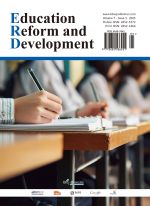A Case Study on the Creation of Kindergarten Material Environment from Children’s Perspective
Abstract
In conventional child research, adult viewpoints often dominate, and children are frequently “objectified,” serving merely as “subjects for study” [1]. Since the 1980s, scholars have increasingly considered children’s issues from a child-centered standpoint, leading to the emergence of the concept known as the “child perspective.” This approach holds significant research value. Incorporating the child perspective into the professional growth of kindergarten teachers might help address existing challenges in teacher development and reinvigorate their professional progress [2]. The author employs interview and observation techniques to examine the current state of material environment creation in Y kindergarten from the child’s point of view. The findings reveal a tendency toward teacher-centeredness, underutilization of available resources, and insufficient educational capabilities among teachers. In response to these observations and challenges, the author recommends enhancing the development of exploratory and challenging outdoor environments, emphasizing the cultivation of shared and communal values in indoor public spaces, and fostering a more autonomous classroom environment that encourages full participation from children.
References
Lu J, 2022, Research on Kindergarten Environment Creation Based on Children’s Perspective, thesis, Hangzhou Normal University.
Zhong X, Gu R, 2024, Children’s Perspective: Bringing Professional Development of Kindergarten Teachers to Life. Preschool Education Research, 2024(9): 28–36.
Huang J, 2020, “Departure” and “Return” – Problems and Reflections on the Creation of Kindergarten Class Environment from the Perspective of Children’s Culture, thesis, Hunan Normal University.
Cai Y, 2020, Action Research on Middle Class Performance Games from the Perspective of Children, thesis, Minnan Normal University.
Guo F, 2015, History of Preschool Education in Foreign Countries. Peking University Press, Beijing, 185–186.
Yu Y, 2021, Garden Students Are Beautiful and Picturesque – A Preliminary Study on the Construction of “Jia · Qu” Cultural Environment in Kindergartens. Good Parent, 2021(28): 74–75.
Huang Y, 2022, Research on the Creation of the Physical Environment of the Central Garden Class Area in Towns and Villages Based on the Perspective of Children, thesis, Guizhou Minzu University.
Ji Z, Tian Y, 2017, On the Construction of Kindergarten Corridor Culture. Examination Weekly, 2017(88): 161–162.
Zhu S, 2018, Some Thoughts on the Activities of Art District. Children’s Art, 2018(6): 28–33.
Li H, 2013, Kindergarten Environment Creation, thesis, Beijing Normal University Press, Beijing, 81.
Fan Y, 2020, The Creation of Outdoor Environment in Kindergarten for Children Returning to Their Original Nature. Preschool Education Research, 2020(9): 89–92.
Ye Q, 2018, The Effective Use of Large Toys. New Curriculum (Comprehensive Edition), 2018(4): 55.
Lai J, 2023, A Case Study of Educational Intervention for Children with Delayed Motor Development in Large Classes from a Child-Friendly Pers. Educational Inquiry, 18(6): 12–15.
Li C, 2022, Child-Centered Integrated Learning Environment in Kindergartens. Preschool Education Research, 2022(8): 87–90.
Yu D, Guan Y, 2016, Discussion on the Creation of Class Material Environment Centering on Children's Development. Journal of Educational Theory and Practice, 2016, 36(8): 19–21.

